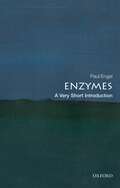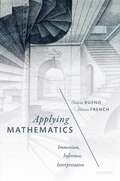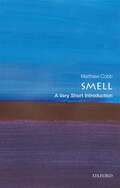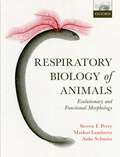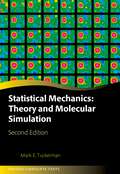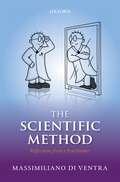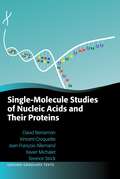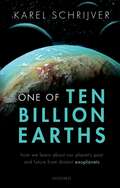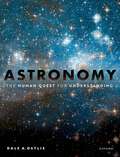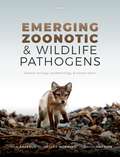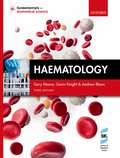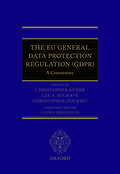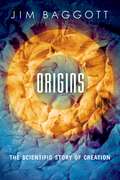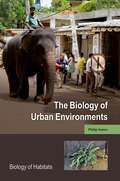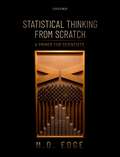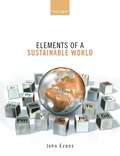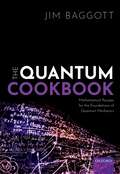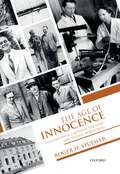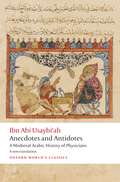- Table View
- List View
Enzymes: A Very Short Introduction (Very Short Introductions)
by Paul EngelEnzymes are the astonishing, tiny molecular machines that make life possible. Each one of these small proteins speeds up a single chemical reaction inside a living organism many millionfold. Working together, teams of enzymes carry out all the processes that collectively we recognise as life, from making DNA to digesting food. This Very Short Introduction explains the why and the how of speeding up these reactions - catalysis - before going on to reveal how we have evolved these catalysts of such extraordinary power and exquisite selectivity. Paul Engel shows how X-ray crystallography has revealed the complex molecular shapes that allow enzymes to function at an extraordinarily sophisticated level. He also examines medical aspects of enzymes, both in the way faulty enzymes cause disease and in the way enzymes can be used for diagnosis and therapy. Finally, he looks at the many varied ways in which individual enzymes, taken out of their biological context, are used nowadays as tools - in washing powders, food production, waste treatment, and chemical synthesis. ABOUT THE SERIES: The Very Short Introductions series from Oxford University Press contains hundreds of titles in almost every subject area. These pocket-sized books are the perfect way to get ahead in a new subject quickly. Our expert authors combine facts, analysis, perspective, new ideas, and enthusiasm to make interesting and challenging topics highly readable.
Enzymes: The Steady-state Approach (Very Short Introductions)
by Paul EngelEnzymes are the astonishing, tiny molecular machines that make life possible. Each one of these small proteins speeds up a single chemical reaction inside a living organism many millionfold. Working together, teams of enzymes carry out all the processes that collectively we recognise as life, from making DNA to digesting food. This Very Short Introduction explains the why and the how of speeding up these reactions - catalysis - before going on to reveal how we have evolved these catalysts of such extraordinary power and exquisite selectivity. Paul Engel shows how X-ray crystallography has revealed the complex molecular shapes that allow enzymes to function at an extraordinarily sophisticated level. He also examines medical aspects of enzymes, both in the way faulty enzymes cause disease and in the way enzymes can be used for diagnosis and therapy. Finally, he looks at the many varied ways in which individual enzymes, taken out of their biological context, are used nowadays as tools - in washing powders, food production, waste treatment, and chemical synthesis. ABOUT THE SERIES: The Very Short Introductions series from Oxford University Press contains hundreds of titles in almost every subject area. These pocket-sized books are the perfect way to get ahead in a new subject quickly. Our expert authors combine facts, analysis, perspective, new ideas, and enthusiasm to make interesting and challenging topics highly readable.
Applying Mathematics: Immersion, Inference, Interpretation
by Otávio Bueno Steven FrenchHow is that when scientists need some piece of mathematics through which to frame their theory, it is there to hand? What has been called 'the unreasonable effectiveness of mathematics' sets a challenge for philosophers. Some have responded to that challenge by arguing that mathematics is essentially anthropocentric in character, whereas others have pointed to the range of structures that mathematics offers. Otávio Bueno and Steven French offer a middle way, which focuses on the moves that have to be made in both the mathematics and the relevant physics in order to bring the two into appropriate relation. This relation can be captured via the inferential conception of the applicability of mathematics, which is formulated in terms of immersion, inference, and interpretation. In particular, the roles of idealisations and of surplus structure in science and mathematics respectively are brought to the fore and captured via an approach to models and theories that emphasize the partiality of the available information: the partial structures approach. The discussion as a whole is grounded in a number of case studies drawn from the history of quantum physics, and extended to contest recent claims that the explanatory role of certain mathematical structures in scientific practice supports a realist attitude towards them. The overall conclusion is that the effectiveness of mathematics does not seem unreasonable at all once close attention is paid to how it is actually applied in practice.
Smell: A Very Short Introduction (Very Short Introductions)
by Matthew CobbOur sense of smell - or olfaction as it is technically known - is our most enigmatic sense. It can conjure up memories, taking us back to very specific places and emotions, whilst powerful smells can induce strong feelings of hunger or nausea. In the animal kingdom smell can be used to find food, a mate, or a home; to sense danger; and to send and receive complex messages with other members of a species. Yet despite its fundamental importance in our mental life and in the existence of all animals, our scientific understanding of how smell works is limited. In this Very Short Introduction, Matthew Cobb describes the latest scientific research on smell in humans and other mammals, in insects, and even in fish. He looks at how smell evolved, how animals use it to navigate and communicate, and disorders of smell in humans. Understanding smell, especially its neurobiology, has proved a big challenge, but olfactory science has revealed genetic factors that determine what we can and cannot smell, and why some people like a given smell while others find it unbearable. He ends by considering future treatments for smell disorders, and speculating on the role of smell in a world of robots. ABOUT THE SERIES: The Very Short Introductions series from Oxford University Press contains hundreds of titles in almost every subject area. These pocket-sized books are the perfect way to get ahead in a new subject quickly. Our expert authors combine facts, analysis, perspective, new ideas, and enthusiasm to make interesting and challenging topics highly readable.
Smell: A Very Short Introduction (Very Short Introductions)
by Matthew CobbOur sense of smell - or olfaction as it is technically known - is our most enigmatic sense. It can conjure up memories, taking us back to very specific places and emotions, whilst powerful smells can induce strong feelings of hunger or nausea. In the animal kingdom smell can be used to find food, a mate, or a home; to sense danger; and to send and receive complex messages with other members of a species. Yet despite its fundamental importance in our mental life and in the existence of all animals, our scientific understanding of how smell works is limited. In this Very Short Introduction, Matthew Cobb describes the latest scientific research on smell in humans and other mammals, in insects, and even in fish. He looks at how smell evolved, how animals use it to navigate and communicate, and disorders of smell in humans. Understanding smell, especially its neurobiology, has proved a big challenge, but olfactory science has revealed genetic factors that determine what we can and cannot smell, and why some people like a given smell while others find it unbearable. He ends by considering future treatments for smell disorders, and speculating on the role of smell in a world of robots. ABOUT THE SERIES: The Very Short Introductions series from Oxford University Press contains hundreds of titles in almost every subject area. These pocket-sized books are the perfect way to get ahead in a new subject quickly. Our expert authors combine facts, analysis, perspective, new ideas, and enthusiasm to make interesting and challenging topics highly readable.
Respiratory Biology of Animals: evolutionary and functional morphology
by Steven F. Perry Markus Lambertz Anke SchmitzOxygen uptake for metabolic energy demand and the elimination of the resulting carbon dioxide is one of the essential processes in all higher life forms; in the case of animals, everything from protozoans to insects and vertebrates including humans. Respiratory Biology of Animals provides a contemporary and truly integrative approach to the topic, adopting a strong evolutionary theme. It covers aerobic metabolism at all levels, from gas exchange organs such as skin, gills, and lungs to mitochondria - the site of cellular respiration. The book also describes the functional morphology and physiology of the circulatory system, which often contains gas-carrying pigments and is important for pH regulation in the organism. A final section describes the evolution of animal respiratory systems. Throughout the book, examples are selected from the entire breadth of the animal kingdom, identifying common themes that transcend taxonomy. Respiratory Biology of Animals is an accessible supplementary text suitable for both senior undergraduate and graduate students taking courses in respiratory biology, comparative animal physiology, and environmental physiology. It is also of relevance and use to the many professional academics requiring a concise but authoritative overview of the topic.
Statistical Mechanics: Theory and Molecular Simulation (Oxford Graduate Texts)
by Mark E. TuckermanScientists are increasingly finding themselves engaged in research problems that cross the traditional disciplinary lines of physics, chemistry, biology, materials science, and engineering. Because of its broad scope, statistical mechanics is an essential tool for students and more experienced researchers planning to become active in such an interdisciplinary research environment. Powerful computational methods that are based in statistical mechanics allow complex systems to be studied at an unprecedented level of detail. This book synthesizes the underlying theory of statistical mechanics with the computational techniques and algorithms used to solve real-world problems and provides readers with a solid foundation in topics that reflect the modern landscape of statistical mechanics. Topics covered include detailed reviews of classical and quantum mechanics, in-depth discussions of the equilibrium ensembles and the use of molecular dynamics and Monte Carlo to sample classical and quantum ensemble distributions, Feynman path integrals, classical and quantum linear-response theory, nonequilibrium molecular dynamics, the Langevin and generalized Langevin equations, critical phenomena, techniques for free energy calculations, machine learning models, and the use of these models in statistical mechanics applications. The book is structured such that the theoretical underpinnings of each topic are covered side by side with computational methods used for practical implementation of the theoretical concepts.
The Scientific Method: Reflections from a Practitioner
by Massimiliano Di VentraThis book looks at how science investigates the natural world around us. It is an examination of the scientific method, the foundation of science, and basis on which our scientific knowledge is built on. Written in a clear, concise, and colloquial style, the book addresses all concepts pertaining to the scientific method. It includes discussions on objective reality, hypotheses and theory, and the fundamental and inalienable role of experimental evidence in scientific knowledge. This collection of personal reflections on the scientific methodology shows the observations and daily uses of an experienced practitioner. Massimiliano Di Ventra also examines the limits of science and the errors we make when abusing its method in contexts that are not scientific, for example, in policymaking. By reflecting on the general method, the reader can critically sort through other types of scientific claims, and judge their ability to apply it in study and in practice.
Single-Molecule Studies of Nucleic Acids and Their Proteins (Oxford Graduate Texts)
by David Bensimon Vincent Croquette Jean-François Allemand Xavier Michalet Terence StrickThis book provides the basis for understanding the elastic properties of nucleic acids (DNA, RNA), the methods used to manipulate them (e.g. optical, magnetic and acoustic tweezers and traps), and how to observe their interactions with proteins (e.g. fluorescence microscopy, FCS, FRET, etc.). It then exemplifies the use of these various methods in the study of three families of DNA enzymes: polymerases, helicases and topoisomerases. The book aims not to be exhaustive, but rather to stimulate the imagination of readers in the application of these single molecule approaches to the study of DNA/RNA and their interactions.
One of Ten Billion Earths: How we Learn about our Planet's Past and Future from Distant Exoplanets
by Karel SchrijverIllustrated with breathtaking images of the Solar System and of the Universe around it, this book explores how the discoveries within the Solar System and of exoplanets far beyond it come together to help us understand the habitability of Earth, and how these findings guide the search for exoplanets that could support life. The author highlights how, within two decades of the discovery of the first planets outside the Solar System in the 1990s, scientists concluded that planets are so common that most stars are orbited by them. The lives of exoplanets and their stars, as of our Solar System and its Sun, are inextricably interwoven. Stars are the seeds around which planets form, and they provide light and warmth for as long as they shine. At the end of their lives, stars expel massive amounts of newly forged elements into deep space, and that ejected material is incorporated into subsequent generations of planets. How do we learn about these distant worlds? What does the exploration of other planets tell us about Earth? Can we find out what the distant future may have in store for us? What do we know about exoworlds and starbirth, and where do migrating hot Jupiters, polluted white dwarfs, and free-roaming nomad planets fit in? And what does all that have to do with the habitability of Earth, the possibility of finding extraterrestrial life, and the operation of the globe-spanning network of the sciences?
Astronomy: The Human Quest for Understanding
by Dale A. OstlieSince humans first looked up at the stars, astronomy has had a particular ability to stir the imagination and challenge the thinking of scientists and non-scientists alike. Astronomy: The Human Quest for Understanding is an introductory astronomy textbook specifically designed to relate to non-science majors across a wide variety of disciplines, nurture their curiosity, and develop vital science-based critical-thinking skills. This textbook provides an introduction to how science operates in practice and what makes it so successful in uncovering nature's secrets. Given that the study of astronomy dates back thousands of years, it is the ideal subject for tracing the development of the physical sciences and how our evolving understanding of nature has influenced, and been influenced by, mathematics, philosophy, religion, geography, politics, and more. This historical approach also illustrates how wrong turns have been taken, and how the inherent self-correcting nature of science through constant verification and the falsifiability of truly scientific theories ultimately leads us back to a more productive path in our quest for understanding. This approach also points out why, as a broadly educated citizenry, students of all disciplines must understand how scientists arrive at conclusions, and how science and technology have become central features of modern society. In discussing this fascinating and beautiful universe of which we are a part, it is necessary to illustrate the fundamental role that mathematics plays in decoding nature's mysteries. Unlike other similar textbooks, some basic mathematics is integrated naturally into the text, together with interpretive language, and supplemented with numerous examples; additional tutorials are provided on the book's companion website. Astronomy: The Human Quest for Understanding leads the reader down the path to our present-day understanding of our Solar System, stars, galaxies, and the beginning and evolution of our universe, along with profound questions still to be answered in this ancient, yet rapidly changing field.
Emerging Zoonotic and Wildlife Pathogens: Disease Ecology, Epidemiology, and Conservation
by Dr Dan Salkeld Dr Skylar Hopkins Prof David HaymanThis accessible book describes a fascinating range of emerging infectious disease outbreaks affecting humans, including rabies, Ebola virus, Lyme disease, bubonic plague, and of course, Covid-19. The book also covers emerging infectious diseases in wildlife, such as Tasmanian devil facial tumour disease, white nose syndrome, mange, and musk ox lungworm. These case studies span the entire range of zoonotic disease emergence pathways, from sheep testicles in Wyoming, USA to butchered bush rats in Vietnam! Transmission dynamics are examined from diverse perspectives - from global drivers of pathogen emergence (including globalization, land use patterns, and changing climates) to outbreak epidemiology (epidemic curves and disease spillover), to conservation and control interventions. Despite a recent explosion of courses on the topic, and a viral pandemic that has affected the entire world, this is the first textbook to focus on pathogen spillover ecology at the human—wildlife interface. Emerging Zoonotic and Wildlife Pathogens serves as an introduction to this multidisciplinary field for upper-level undergraduate students and graduate students interested in disease ecology, veterinary epidemiology, public health, and conservation. It will also be relevant to a broader interdisciplinary audience of conservation biologists and public health specialists, and even the interested public.
Haematology (Fundamentals of Biomedical Science)
by Gary Moore Gavin Knight Andrew BlannBiomedical Scientists are the foundation of modern healthcare, from cancer screening to diagnosing HIV, from blood transfusion for surgery to food poisoning and infection control. Without Biomedical Scientists, the diagnosis of disease, the evaluation of the effectiveness of treatment, and research into the causes and cures of disease would not be possible. The Fundamentals of Biomedical Science series has been written to reflect the challenges of practicing Biomedical Science today. It draws together essential basic science with insights into laboratory practice to show how an understanding of the biology of disease is coupled to the analytical approaches that lead to diagnosis. Assuming only a minimum of prior knowledge, the series reviews the full range of disciplines to which a Biomedical Scientist may be exposed - from microbiology to cytopathology to transfusion science. Haematology provides a broad-ranging overview of the study of blood, the dynamic fluid that interfaces with all organs and tissues to meditate essential transport and regulatory functions. Written with the needs of the Biomedical Scientist centre-stage, it provides a firm grounding in the physiology of blood, and the key pathophysiological states that can arise. It demonstrates throughout how an understanding of physiology underpins the key investigations carried out by a Biomedical Scientist to forge a clear link between science and practice. The third edition has been thoroughly revised to remain up to date with the latest scientific research, with new sections and case studies added to support your learning. The online resources to accompany Haematology have also been updated and include multiple choice questions to test understanding, a Journal Club which provides discussion questions for relevant research papers, and answers to case study and self-check questions. Students and lecturers will also have access to the FBMS series online resources, which feature video interviews with practicing biomedical scientists and 'in the lab' footage showing biomedical techniques. Also available as an ebook with functionality, navigation features, and links that offer extra learning support.
Haematology (Fundamentals of Biomedical Science)
by Gary Moore Andrew Blann Gavin KnightBiomedical Scientists are the foundation of modern healthcare, from cancer screening to diagnosing HIV, from blood transfusion for surgery to food poisoning and infection control. Without Biomedical Scientists, the diagnosis of disease, the evaluation of the effectiveness of treatment, and research into the causes and cures of disease would not be possible. The Fundamentals of Biomedical Science series has been written to reflect the challenges of practicing Biomedical Science today. It draws together essential basic science with insights into laboratory practice to show how an understanding of the biology of disease is coupled to the analytical approaches that lead to diagnosis. Assuming only a minimum of prior knowledge, the series reviews the full range of disciplines to which a Biomedical Scientist may be exposed - from microbiology to cytopathology to transfusion science. Haematology provides a broad-ranging overview of the study of blood, the dynamic fluid that interfaces with all organs and tissues to meditate essential transport and regulatory functions. Written with the needs of the Biomedical Scientist centre-stage, it provides a firm grounding in the physiology of blood, and the key pathophysiological states that can arise. It demonstrates throughout how an understanding of physiology underpins the key investigations carried out by a Biomedical Scientist to forge a clear link between science and practice. The third edition has been thoroughly revised to remain up to date with the latest scientific research, with new sections and case studies added to support your learning. The online resources to accompany Haematology have also been updated and include multiple choice questions to test understanding, a Journal Club which provides discussion questions for relevant research papers, and answers to case study and self-check questions. Students and lecturers will also have access to the FBMS series online resources, which feature video interviews with practicing biomedical scientists and 'in the lab' footage showing biomedical techniques. Also available as an ebook with functionality, navigation features, and links that offer extra learning support.
The EU General Data Protection Regulation (GDPR): A Commentary
FREE Update to Selected Commentaries This new book provides an article-by-article commentary on the new EU General Data Protection Regulation. Adopted in April 2016 and applicable from May 2018, the GDPR is the centrepiece of the recent reform of the EU regulatory framework for protection of personal data. It replaces the 1995 EU Data Protection Directive and has become the most significant piece of data protection legislation anywhere in the world. This book is edited by three leading authorities and written by a team of expert specialists in the field from around the EU and representing different sectors (including academia, the EU institutions, data protection authorities, and the private sector), thus providing a pan-European analysis of the GDPR. It examines each article of the GDPR in sequential order and explains how its provisions work, thus allowing the reader to easily and quickly elucidate the meaning of individual articles. An introductory chapter provides an overview of the background to the GDPR and its place in the greater structure of EU law and human rights law. Account is also taken of closely linked legal instruments, such as the Directive on Data Protection and Law Enforcement that was adopted concurrently with the GDPR, and of the ongoing work on the proposed new E-Privacy Regulation.
The EU General Data Protection Regulation (GDPR): A Commentary
by Christopher Kuner, Lee A. Bygrave and Christopher DockseyFREE Update to Selected Commentaries This new book provides an article-by-article commentary on the new EU General Data Protection Regulation. Adopted in April 2016 and applicable from May 2018, the GDPR is the centrepiece of the recent reform of the EU regulatory framework for protection of personal data. It replaces the 1995 EU Data Protection Directive and has become the most significant piece of data protection legislation anywhere in the world. This book is edited by three leading authorities and written by a team of expert specialists in the field from around the EU and representing different sectors (including academia, the EU institutions, data protection authorities, and the private sector), thus providing a pan-European analysis of the GDPR. It examines each article of the GDPR in sequential order and explains how its provisions work, thus allowing the reader to easily and quickly elucidate the meaning of individual articles. An introductory chapter provides an overview of the background to the GDPR and its place in the greater structure of EU law and human rights law. Account is also taken of closely linked legal instruments, such as the Directive on Data Protection and Law Enforcement that was adopted concurrently with the GDPR, and of the ongoing work on the proposed new E-Privacy Regulation.
Origins: The Scientific Story of Creation
by Jim BaggottWhat is life? Where do we come from and how did we evolve? What is the universe and how was it formed? What is the nature of the material world? How does it work? How and why do we think? What does it mean to be human? How do we know? There are many different versions of our creation story. This book tells the version according to modern science. It is a unique account, starting at the Big Bang and travelling right up to the emergence of humans as conscious intelligent beings, 13.8 billion years later. Chapter by chapter, it sets out the current state of scientific knowledge: the origins of space and time; energy, mass, and light; galaxies, stars, and our sun; the habitable earth, and complex life itself. Drawing together the physical and biological sciences, Baggott recounts what we currently know of our history, highlighting the questions science has yet to answer.
Origins: The Scientific Story of Creation
by Jim BaggottWhat is life? Where do we come from and how did we evolve? What is the universe and how was it formed? What is the nature of the material world? How does it work? How and why do we think? What does it mean to be human? How do we know? There are many different versions of our creation story. This book tells the version according to modern science. It is a unique account, starting at the Big Bang and travelling right up to the emergence of humans as conscious intelligent beings, 13.8 billion years later. Chapter by chapter, it sets out the current state of scientific knowledge: the origins of space and time; energy, mass, and light; galaxies, stars, and our sun; the habitable earth, and complex life itself. Drawing together the physical and biological sciences, Baggott recounts what we currently know of our history, highlighting the questions science has yet to answer.
The Biology of Urban Environments (Biology of Habitats Series)
by Philip JamesHow do plants, animals, and humans manage to survive and adapt to the urban environment? This book provides a comprehensive coverage of biological matters related to urban environments presenting both the conceptual and theoretical underpinnings, and practical examples required to understand and address the challenges presented by this novel environment. The Biology of Urban Environments focusses on urban denizens: species (both domesticated and non-domesticated) that live for all or part of their life cycle in towns and cities. The biology of household plants and companion animals is discussed alongside that of species that have become feral or have not been domesticated. Temporal and spatial distribution patterns are set out and generalizations are made while exceptions are also discussed. The various strategies used and the genotypic, phenotypic, and behavioural adaptions of plants and animals in the face of the challenges presented by urban environments are explained. The final two chapters contain a discussion of the impacts of urban environments on human biology and suggestions on how this understanding might be used to address the increasing human health burden associated with illnesses that are characteristic of urbanites in the early twenty-first century.
Statistical Thinking from Scratch: A Primer for Scientists
by M. D. EdgeResearchers across the natural and social sciences find themselves navigating tremendous amounts of new data. Making sense of this flood of information requires more than the rote application of formulaic statistical methods. The premise of Statistical Thinking from Scratch is that students who want to become confident data analysts are better served by a deep introduction to a single statistical method than by a cursory overview of many methods. In particular, this book focuses on simple linear regression-a method with close connections to the most important tools in applied statistics-using it as a detailed case study for teaching resampling-based, likelihood-based, and Bayesian approaches to statistical inference. Considering simple linear regression in depth imparts an idea of how statistical procedures are designed, a flavour for the philosophical positions one assumes when applying statistics, and tools to probe the strengths of one's statistical approach. Key to the book's novel approach is its mathematical level, which is gentler than most texts for statisticians but more rigorous than most introductory texts for non-statisticians. Statistical Thinking from Scratch is suitable for senior undergraduate and beginning graduate students, professional researchers, and practitioners seeking to improve their understanding of statistical methods across the natural and social sciences, medicine, psychology, public health, business, and other fields.
Elements of a Sustainable World
by John EvansWe have 118 known chemical elements as our palette in our context of sustaining our world. Our context is considered in terms of the four spheres of the ancient world: Earth, Air, Fire and Water. This book shows how chemical principles can be used to understand the pressures on our world, spanning from greenhouse emissions through freshwater supplies to energy generation and storage. The supply of the chemical elements is key to their contribution to alleviating these pressures. Most synthetic and radioactive elements are not available in sufficient supply to contribute in this. Some solutions, such as wind turbines, batteries, fuel cells and automotive exhaust remediation pose questions about sustainable supplies of critical elements. With an eye on the target of the IPCC of capping the temperature anomaly to 1.5 oC (RCP2.6), options for carbon capture and storage, and the generation of energy and element supply from the sea are assessed. The consequences of the escape of plastics and pharmaceuticals into the wider environment for water integrity are also considered. This book is designed around providing a one semester course for students who have entered at least the second level of university chemistry. It provides explanations and entries to current environmental issues. For students of environmental science, it provides an understanding of the chemical principles underpinning the causes and possible solutions to these issues. Each chapter has a set appropriate study questions. A study guide is available for the book.
The Quantum Cookbook: Mathematical Recipes for the Foundations of Quantum Mechanics
by Jim BaggottQuantum mechanics is an extraordinarily successful scientific theory. But it is also completely mad. Although the theory quite obviously works, it leaves us chasing ghosts and phantoms; particles that are waves and waves that are particles; cats that are at once both alive and dead; lots of seemingly spooky goings-on; and a desperate desire to lie down quietly in a darkened room. The Quantum Cookbook explains why this is. It provides a unique bridge between popular exposition and formal textbook presentation, written for curious readers with some background in physics and sufficient mathematical capability. It aims not to teach readers how to do quantum mechanics but rather helps them to understand how to think about quantum mechanics. Each derivation is presented as a 'recipe' with listed ingredients, including standard results from the mathematician's toolkit, set out in a series of easy-to-follow steps. The recipes have been written sympathetically, for readers who - like the author - will often struggle to follow the logic of a derivation which misses out steps that are 'obvious', or which use techniques that readers are assumed to know.
The Age of Innocence: Nuclear Physics between the First and Second World Wars
by Roger H. StuewerThe two decades between the first and second world wars saw the emergence of nuclear physics as the dominant field of experimental and theoretical physics, owing to the work of an international cast of gifted physicists. Prominent among them were Ernest Rutherford, George Gamow, the husband and wife team of Frédéric and Irène Joliot-Curie, John Cockcroft and Ernest Walton, Gregory Breit and Eugene Wigner, Lise Meitner and Otto Robert Frisch, the brash Ernest Lawrence, the prodigious Enrico Fermi, and the incomparable Niels Bohr. Their experimental and theoretical work arose from a quest to understand nuclear phenomena; it was not motivated by a desire to find a practical application for nuclear energy. In this sense, these physicists lived in an 'Age of Innocence'. They did not, however, live in isolation. Their research reflected their idiosyncratic personalities; it was shaped by the physical and intellectual environments of the countries and institutions in which they worked. It was also buffeted by the political upheavals after the Great War: the punitive postwar treaties, the runaway inflation in Germany and Austria, the Great Depression, and the intellectual migration from Germany and later from Austria and Italy. Their pioneering experimental and theoretical achievements in the interwar period therefore are set within their personal, institutional, and political contexts. Both domains and their mutual influences are conveyed by quotations from autobiographies, biographies, recollections, interviews, correspondence, and other writings of physicists and historians.
Anecdotes and Antidotes: A Medieval Arabic History of Physicians (Oxford World's Classics)
by Ibn Abi Usaybi'ahTo my knowledge...no one...has ever written a comprehensive book dealing with physicians through the ages and recounting their history in a coherent fashion. So wrote Syrian physician Ibn Abi Usaybi'ah, circa 1243, as he embarked on the first world history of medicine ever attempted. Many physicians served at the royal courts of their time and were firmly part of the intellectual and cultural scene, where the ability to write stylishly and entertain one's peers in both prose and verse was the basis of social credibility. The work Ibn Abi Usaybi'ah created contains over 432 biographical accounts of physicians from those of ancient Greece, such as Galen, through Avicenna and Maimonides, to the author's own colleagues of the 13th century. As such, his work includes important accounts of medical activity in medieval hospitals. Through this book, a window opens not only on to the origins of the medical profession, but also into the truly multi-cultural, multi-religious world of the medieval Middle East. Anecdotes and Antidotes is an abridged version of this world history of medicine. It comprises 103 biographies of physicians and philosophers, organized geographically and chronologically, from the 4th century BC to the 13th century, and includes seminal Muslim, Christian and Jewish figures. It contains vital medical and historical information, as well as revealing the cultural values, interests and concerns of the literary and intellectual elite of the time.
Anecdotes and Antidotes: A Medieval Arabic History of Physicians (Oxford World's Classics)
by Ibn Abi Usaybi'ahTo my knowledge...no one...has ever written a comprehensive book dealing with physicians through the ages and recounting their history in a coherent fashion. So wrote Syrian physician Ibn Abi Usaybi'ah, circa 1243, as he embarked on the first world history of medicine ever attempted. Many physicians served at the royal courts of their time and were firmly part of the intellectual and cultural scene, where the ability to write stylishly and entertain one's peers in both prose and verse was the basis of social credibility. The work Ibn Abi Usaybi'ah created contains over 432 biographical accounts of physicians from those of ancient Greece, such as Galen, through Avicenna and Maimonides, to the author's own colleagues of the 13th century. As such, his work includes important accounts of medical activity in medieval hospitals. Through this book, a window opens not only on to the origins of the medical profession, but also into the truly multi-cultural, multi-religious world of the medieval Middle East. Anecdotes and Antidotes is an abridged version of this world history of medicine. It comprises 103 biographies of physicians and philosophers, organized geographically and chronologically, from the 4th century BC to the 13th century, and includes seminal Muslim, Christian and Jewish figures. It contains vital medical and historical information, as well as revealing the cultural values, interests and concerns of the literary and intellectual elite of the time.
